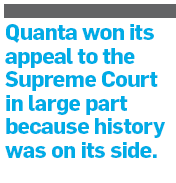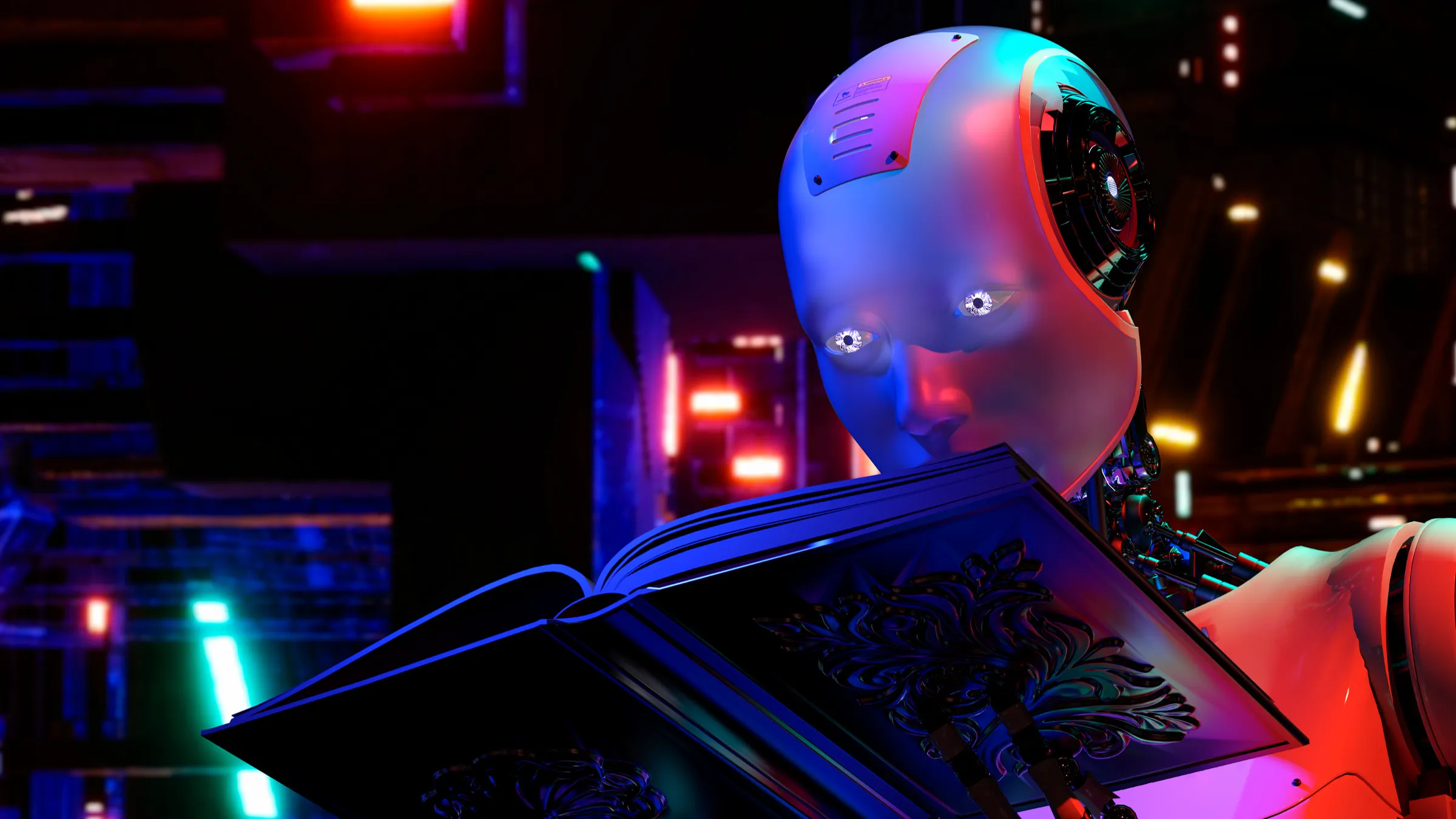
Owners of patents and copyrights have the right to control the manufacture and sale of products embodying their creations, and that is as it should be. But do they have the right to control all downstream uses, reuses, and transactions as to products embodying their intellectual property (IP)?
Common sense tells us that when we buy a patented machine or a copyrighted book, we have the right to use it for whatever purposes we choose and to resell it. The law backs up this expectation by providing that the first authorized sale of products in the marketplace "exhausts" IP rights in those products.
Quantifying the full value to society of IP exhaustion rules is not easy, but exhaustion clearly makes commerce flow more freely, reduces transaction costs, facilitates follow-on innovation, and promotes competition in primary and secondary markets.
In June 2008 the U.S. Supreme Court in Quanta Computer, Inc. v. LG Electronics, Inc. unanimously affirmed the continuing vitality of the exhaustion doctrine, reversing as erroneous a decision by the Court of Appeals for the Federal Circuit (CAFC) that had eroded this rule’s application.
Quanta held (1) that the exhaustion rule applies to method as well as apparatus claims and (2) because LGE’s license with Intel authorized the latter to sell components to customers such as Quanta, exhaustion shielded Quanta from patent liability even though LGE’s license with Intel sought to limit uses that Intel’s customers could make of products purchased from Intel.
Quanta was an important victory for the IT industry, as it thwarts efforts to claim royalties from all downstream users of patented inventions. In this column I will explain LGE’s theory about the exhaustion doctrine and why the Supreme Court rejected LGE’s analysis. I will also consider some implications of Quanta for contractual restrictions on uses, reuses, and redistributions of products embodying patented inventions.
The LGE v. Quanta Dispute
Intel and LGE entered into cross-licensing agreements as to their patent portfolios. The LGE license allowed Intel to manufacture and sell microprocessors and chipsets that, when combined with other components, implemented some of LGE’s inventions. LGE’s license allowed Intel to pass on the benefits of the LGE license to customers who purchased Intel-made components, but not to those who mixed Intel and non-Intel components in their systems. LGE’s license obliged Intel to notify its customers about this license limitation. After Quanta purchased Intel products and combined them with non-Intel components, LGE sued Quanta for patent infringement.
The LGE patents in Quanta involved: a method for ensuring that only the most current data would be retrieved from main memory; a method for coordinating read and write requests within computer systems; and a method for managing data traffic on a bus connecting computer components so that no one device could monopolize the bus.
The microprocessors and chipsets that Quanta bought from Intel did not fully embody or practice LGE’s patented inventions for the obvious reason that the methods could not be practiced without combining the Intel products with other components (for example, main memory) capable of carrying out the processes.
LGE claimed that because the Intel products did not and could not embody the patented inventions, the patent exhaustion doctrine did not apply. In its view, patent rights are only exhausted when the patentee has authorized the making and selling of a product that fully embodies the invention.
The CAFC agreed with LGE that the Intel products were only components designed for use in the patented processes, not implementations of those processes. More generally, the CAFC opined that method claims, by their very nature, were not subject to the exhaustion rule. The CAFC thus gave LGE a green light to sue all of Intel’s microprocessor customers for patent infringement unless they purchased Intel-only components for their systems.
Why Quanta Won
Quanta won its appeal to the Supreme Court in large part because history was on its side. Indeed, the opening sentence of the Quanta decision states: "For over 150 years, this Court has applied the doctrine of patent exhaustion to limit the patent rights that survive the initial authorized sale of a patented item." The Court reviewed several cases in which exhaustion defenses had succeeded, including the Univis case, which, like Quanta, involved method claims.
Univis owned patents pertaining to eyeglass lenses. It licensed certain firms to make blank lenses; it also licensed wholesalers to grind the blanks to make finished lenses and retailers to sell the finished lenses to consumers. U.S. antitrust authorities challenged Univis’ effort to control the downstream market as an unreasonable restraint on trade. In 1942, the Supreme Court ruled that Univis’ patent rights had been exhausted by its authorization of the manufacture and sale of blank lenses. Even though the blanks did not embody the whole of Univis’ invention, they embodied essential features of the invention and the intended use of the blanks was to practice the invention. This sufficed to exhaust Univis’ patent rights.
The Court in Quanta observed: "Just as the lens blanks in Univis did not fully practice the patents at issue because they had not been ground into finished lenses…the Intel products cannot practice the LGE patents—or indeed function at all—until they are combined with memory and buses in a computer system." All that stood between the Intel components and completion of LGE’s patented processes was the addition of standard components, such as main memory.
The Court observed that the exhaustion doctrine would be a "dead letter unless it is triggered by the sale of components that essentially, even if not completely, embody an invention." The "dead letter" danger was especially keen because of how simple it would be for "[p]atentees seeking to avoid the patent exhaustion doctrine [to] simply draft their patent claims to describe a method rather than an apparatus."
The CAFC’s ruling would allow patentees to intrude deeply into the stream of commerce and upset settled expectations about the consequences of purchasing authorized products from licensed manufacturers. The Supreme Court could not accept this "end run" around the exhaustion doctrine.
Implications of Quanta
Quanta will certainly protect downstream customers from LGE-like attempts to enforce license restrictions as to goods embodying the whole or material parts of patented inventions. However, the Supreme Court in Quanta "expressed] no opinion on whether contract damages might be available [to patent owners] even though exhaustion operates to eliminate patent damages."
Left unresolved was an important set of questions as to whether (or to what extent) contractual restrictions on customer uses or distributions of products embodying the invention are consistent with patent law’s exhaustion doctrine.
Of particular significance is whether conditional sales of goods embodying patented inventions fall outside the exhaustion rule, as the CAFC opined in Mallinkrodt, Inc. v. Medipart, Inc. Mallinkrodt’s patents were for inventions embodied in medical devices. It sold these devices inscribed with a legend that they were "for single use only." Ignoring this legend, certain customers (hospitals) contracted with Medipart to prepare the devices for reuse. When Mallinkrodt sued Medipart for patent infringement, Medipart asserted that the patent exhaustion doctrine shielded it from liability.
In Mallinkrodt, the CAFC treated exhaustion as a default rule that could be, and had been, overridden by sales made conditional on the purchaser’s acceptance of single-use-only terms. (The CAFC has also enforced restrictive legends on bags of seeds that purport to forbid purchasers to plant second-generation seeds derived from purchased seeds.) Failure to abide by such restrictive legends, in the CAFC’s view, gives rise not only to liability for breach of contract, but also for patent infringement.
Quanta won its appeal to the Supreme Court in large part because history was on its side.
Certain statements in Quanta suggest the patent exhaustion ruling in Mallinkrodt is wrong. Among other things, Quanta states that "[t]he longstanding doctrine of patent exhaustion provides that the initial authorized sale of a patented item terminates all patent rights to that item." Thus, when Mallinkrodt sold its medical devices to hospitals, its patent rights were exhausted because these were "initial authorized sale[s]" under Quanta.
It is, of course, a separate question whether Mallinkrodt could sue the hospitals for breach of a single-use-only term of its sales contracts. Some Supreme Court and other precedents cast doubt on the notion that putting a restrictive legend on a product creates a contractual obligation to abide by the restriction. Yet, some cases have enforced restrictive terms of non-negotiated mass market licenses.
Even so, Medipart should not be liable for breach of contract, as it was not a party to the sale between Mallinkrodt and the hospitals. Contracts only bind those who entered into them, not all others in the world.
License Versus Sale?
It is also a separate question whether exhaustion applies if patentees "license" rather than "sell" their products to customers. Negotiated license restrictions will likely be enforceable as between a patentee and its licensees, but should IP rights be exhausted as to mass-market software just because developers characterize their contractual arrangements with customers as "licenses" rather than as "sales"?
The case law thus far is mixed about how much deference courts should give to such designations. Vernor v. Autodesk, Inc. is the most recent U.S. case to consider this issue. The lawsuit arose because Autodesk objected to Vernor’s efforts to sell used copies of Autodesk software on eBay. Vernor sought a declaratory judgment that his sale of the software on eBay was protected by copyright’s exhaustion doctrine.
It is a separate question whether exhaustion applies if patentees "license" rather than "sell" their products to customers.
Autodesk moved to dismiss Vernor’s lawsuit by arguing that the exhaustion doctrine didn’t apply because Autodesk doesn’t sell its software to customers, but only licenses it on terms that expressly forbid retransfer of the software. (Remember, there must be "an initial authorized sale" to exhaust IP rights.) Autodesk further claimed that Vernor’s sale of the software infringed Autodesk’s copyright as an unauthorized distribution of its software to members of the public.
The court in Vernor took note of Autodesk’s characterization of the transaction as a "license," but did not consider this designation to be controlling. Instead, it examined the nature of Autodesk’s commercial dealings in this software and decided they were more aptly characterized as sales than licenses. Hence, exhaustion protected Vernor from copyright liability. Autodesk has appealed this ruling.
Conclusion
Quanta was an important step in preservation of IP exhaustion rules. The decision provides a sound basis for thwarting other end runs around IP exhaustion rules such as efforts to impose conditional sales and mass market license restrictions on customers. It remains to be seen whether the CAFC and other courts will recognize that the logic of Quanta should produce this result.



Join the Discussion (0)
Become a Member or Sign In to Post a Comment